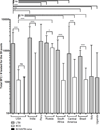A side-by-side comparison of T cell reactivity to fifty-nine Mycobacterium tuberculosis antigens in diverse populations from five continents
- PMID: 26277695
- PMCID: PMC4666753
- DOI: 10.1016/j.tube.2015.07.001
A side-by-side comparison of T cell reactivity to fifty-nine Mycobacterium tuberculosis antigens in diverse populations from five continents
Abstract
We compared T cell recognition of 59 prevalently recognized Mycobacterium tuberculosis (MTB) antigens in individuals latently infected with MTB (LTBI), and uninfected individuals with previous BCG vaccination, from nine locations and populations with different HLA distribution, MTB exposure rates, and standards of TB care. This comparison revealed similar response magnitudes in diverse LTBI and BCG-vaccinated cohorts and significant correlation between responses in LTBIs from the USA and other locations. Many antigens were uniformly recognized, suggesting suitability for inclusion in vaccines targeting diverse populations. Several antigens were similarly immunodominant in LTBI and BCG cohorts, suggesting applicability for vaccines aimed at boosting BCG responses. The panel of MTB antigens will be valuable for characterizing MTB-specific CD4 T cell responses irrespective of ethnicity, infecting MTB strains and BCG vaccination status. Our results illustrate how a comparative analysis can provide insight into the relative immunogenicity of existing and novel vaccine candidates in LTBIs.
Keywords: BCG; CD4; LTBI; T cell antigen; Tuberculosis; Vaccine.
Copyright © 2015 Elsevier Ltd. All rights reserved.
Conflict of interest statement
Figures




References
-
- Comstock GW. Epidemiology of tuberculosis. Am Rev Respir Dis. 1982;125:8–15. - PubMed
-
- Kaufmann SH. Is the development of a new tuberculosis vaccine possible? Nat Med. 2000;6:955–960. - PubMed
-
- Andrews JR, Noubary F, Walensky RP, Cerda R, Losina E, Horsburgh CR. Risk of progression to active tuberculosis following reinfection with Mycobacterium tuberculosis. Clinical infectious diseases : an official publication of the Infectious Diseases Society of America. 2012;54:784–791. - PMC - PubMed
Publication types
MeSH terms
Substances
Grants and funding
LinkOut - more resources
Full Text Sources
Other Literature Sources
Research Materials

